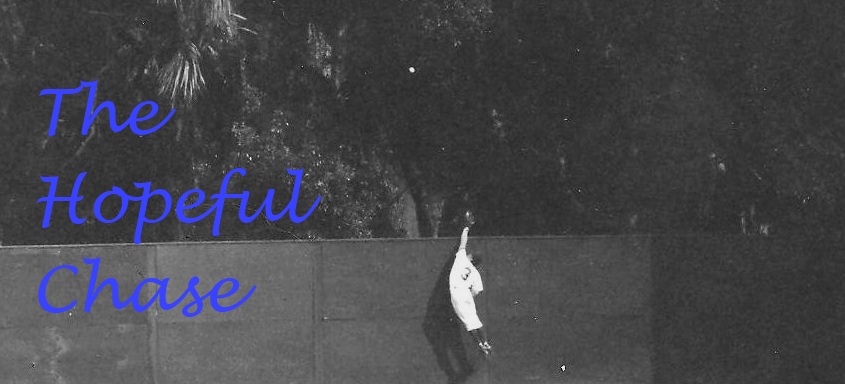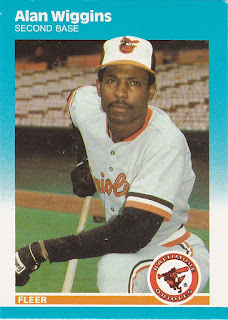Baltimore Orioles Victory Number 15: 10-7 over the Minnesota Twins
1987 Fleer Update Alan Wiggins
With the sporting world on hold due to the novel coronavirus shutting down the world for a few months we here at The Hopeful Chase are going to our rain delay programming. For the last two seasons we've posted a baseball card following every Baltimore Orioles victory (I know, talk about the minimum commitment required). It's fun and keeps us writing about baseball and collecting. Rather than sit back and stare forlornly at the outside world we've decided to continue the series with a season from the past. The season of choice - 1987. Please enjoy.
Before I started this project there were a couple of things I knew about Alan Wiggins. He was fast, he had a tendency to
get picked off, he was suspended for drug use, and he was one of the first professional athletes to die from complications of the AIDS virus. That pretty much summed up my Alan Wiggins knowledge.
Now having read roughly 3 1/2 months worth of newspaper articles about the 1987 Baltimore Orioles a much more complicated picture of Alan Wiggins the person and Alan Wiggins the ballplayer have emerged. This would be the final season that the former first round pick (8th overall) of the Los Angeles Dodgers would play and it would be a tumultuous one.
The Baltimore Orioles experience with Wiggins began in 1985. With the second base combination of Rich Dauer and Lenn Sakata struggling and no true leadoff hitter on the roster the Orioles were looking for an upgrade. Meanwhile in San Diego, Wiggins had gone from a key part of a 1984 Padres team that made it to the World Series to persona non grata.
Things looked pretty good to start the 1985 season. He signed a new, four-year deal with the Padres that was worth almost $3 million making him one of the highest paid second baseman in the league. The drug issues that had led to him missing two months of the 1982 season seemed to be behind him and he was excelling on the field. He was a spark plug at the top of the Padres line-up whose speed (70 stolen bases in 1984) kept pitchers occupied and led to a lot of fastballs to the number two-hitter in the San Diego line-up: Tony Gwynn.
Then, as spring training was nearing its climax, a hard slide at second base by Brook Jacoby upended Wiggins and led to a knee injury for the Padres infielder. He returned in mid-April, but the results were not there. In 10 games he mustered only 2 hits and 2 walks and he was thrown out in his steal attempt. Then on April 25th, he didn't show up for a game against the Dodgers. For two days the team didn't know where he was. When they were finally able to contact him, they found out that he had re-entered a rehabilitation clinic.
While he was in rehab, the Padres brass made the decision that Wiggins would not play for them for the rest of the season. The players union was less than amused by that unilateral decision. Under the league's new drug policy he was considered a first-time offender and not subject to a suspension since he had gone through rehab. The union's position was that as long as he was cleared by doctors to play, he should be allowed to play.
Things got acrimonious and the Padres declared at one point that he would never play for them again. Thus began the trade negotiations. The Orioles quickly emerged as a leading trade partner but were wary of his contract and the possibility that he could relapse again*. The Padres weren't happy with the offers they were getting. In the end, a deal was reached.
Wiggins was traded to the Orioles for Roy Lee Jackson and a player to be named later. That player ended up being Rich Caldwell, a minor league player who never made it to the majors. In 85 games for the O's Wiggins hit .285, led the team with 30 stolen bases and scored 43 runs. Exactly what they needed from him.
The numbers went down in 1986 as the Orioles coasted into last place for the first time in franchise history under the less-than-motivated tutelage of Earl Weaver. Wiggins drew the ire of his manager who reportedly called him the "absolutely the worst ballplayer I have ever seen" (at least according to a column by Tom Boswell in August). Wiggins was sent down to Rochester in the summer before being recalled in September for a late-season appearances after the Orioles had faded from the playoff race.
With Weaver comfortably back on the golf course in 1987 and new skipper Cal Ripken, Sr. manning the helm it seemed that Wiggins was down to his last chance in Baltimore. Rick Burleson had been signed to play second base full time and the outfield was full of other players. Wiggins had no position and wasn't especially well-liked in the clubhouse.
He did the one thing he could do - played his way onto the team. He hit over .400 and had a .524 on-base percentage. There was no way Ripken, Sr. could justify leaving him out of the line-up so he made the unorthodox move of naming him DH and installing him at the top of the order.
The move paid off early in the season. At this point in the season (May 12th) Wiggins was slashing .322/.380/.407. His production, coupled with a lack of offense from Burleson had allowed the manager to move Wiggins back to second base full time and insert slugger Larry Sheets into the DH spot.
Unfortunately, this would be a high-water mark for Wiggins. As the season moved on, his production stalled, his offense disappeared and the work he had done to get along with his teammates seemed to be unwinding.
By the end of the summer he would be suspended from the team following a batting practice scuffle with Jim Dwyer and a disputed altercation with his manager. Ripken, Sr. alleged that Wiggins grabbed his uniform following a shouting match that Wiggins suggested was started after the manager uttered a racial slur. Both parties denied the other's allegations but the die had been cast and Wiggins was suspended for three games.
He returned to the line-up and dropped a grievance that he had filed against the club, but knew his days were numbered. Then on September 1st he was suspended by the league. Details at the time were scarce, but reports came out that he had failed at least one more drug test. After the season ended the Orioles in essence bought him out of the remainder of his contract paying him $586,242 of the $938,372 he was owed.
If we stopped there with the narrative it would do a grace injustice to understanding who Alan Wiggins was. For all the reports of him being a menace in the clubhouse there were the stories from his friends that painted a different story. They talk about a man who was deeply intelligent: a story circulated at the time of his depth that during his stint in Baltimore the organization administered an I.Q. test to the team and the only person that scored higher was Earl Weaver.
He also loved to argue, not just because he was stubborn or confrontational, just because he found it fun to debate other people or, as he once said, because he was "tired of talking about sliders and putting". His humor slanted to the sarcastic. For example, the incident that touched off his skirmish with Dwyer resulted from a "hit him in the head" wisecrack directed at the batting practice pitcher while Dwyer was in the cage.
Unfortunately, sarcasm and aloofness can be misconstrued in a baseball clubhouse. Especially in one that isn't winning a lot of games. Wiggins had few friends in baseball, Lee Lacy is mentioned as one of the few he had in Baltimore. The fact that he replaced a popular player in Rich Dauer may have spoiled his relationships with some key veterans from the very get go.
Something that didn't register to me as an 10-year-old kid following the team at the time was how dysfunctional the Orioles clubhouse was in those years. Players (and managers) didn't really care for the way the club operated. Ken Dixon voiced his displeasure at his bullpen demotion, Floyd Rayford was considering filing a grievance against the club as they had sent him down days before he reached his five-year major league service anniversary which would have guaranteed his salary. Later in the year Rick Burleson would make his displeasure with the way he was treated known as well.
Cal Ripken, Sr. may have been the model of the Oriole Way as a coach, but he strikes me as one of the original hard-asses to play for. If he didn't agree with you, you were in for a difficult time.
Reading the report of his actions,and the peaks and valleys of his moods, makes it sound like he battled depression, especially after being traded to Baltimore after spending most of his life in California. He was raised by a single mother who developed Alzheimer's when he was in the Padres organization and some close to him says that greatly affected his personality.
The way his big contract was paid out shows that he did plan for the future and life after baseball. According to reports at the time, $1.6 million of the $2.8 million deal was deferred. Portions of the salaries he was paid in 1985, 1986, and 1987 were placed in an account set to earn 8% interest. From that account he would be paid $100,000 every year for the first 10 years following his retirement, with the rest of the money paid out in the 11th year.
Despite marital troubles he remained with his wife as he didn't want his children to grow up without a father like he did. While they may not have known him, his kids did alright. His daughter Candice Wiggins attended Stanford and played in the WNBA. His son Alan, Jr. and other daughter Cassandra also played college basketball.
Had he played in a different era, perhaps his story is different. Maybe with some of the services available today he doesn't walk away from the game at the age of 29. Alan Wiggins stands as an example that players aren't robots. They may be blessed with extraordinary talent to run, throw, or hit a baseball, but they are human and that can affect the way they play the game.
* From an article about the trade: "They did agree to pick up his entire four-year, $2.8 million contract, but in the event of a relapse, they can release him and not be fully responsible for his salary. First, he'd have to use up his last 25 days of protection under the Joint Drug Agreement (each player is covered by the agreement for 60 days), and then, if the Orioles don't want him, they could release him while Wiggins would give up one-third of his salary.
The rest of the money would be paid partly by the Padres and partly by the Orioles. If the relapse occurred in Wiggins' first year in Baltimore, San Diego would pay about 50% of his remaining contract. In the second year, San Diego would pay about 25%. In the third year, it'd be 10%. In the fourth year, the Padres would have no obligations."
Friend, T. (1985, Jun 28). Wiggins' trade to orioles is finally completed: [home edition]. Los Angeles Times (Pre-1997 Fulltext) Retrieved from https://search-proquest-com.ezproxy.slcpl.org/docview/292139118?accountid=3357

















